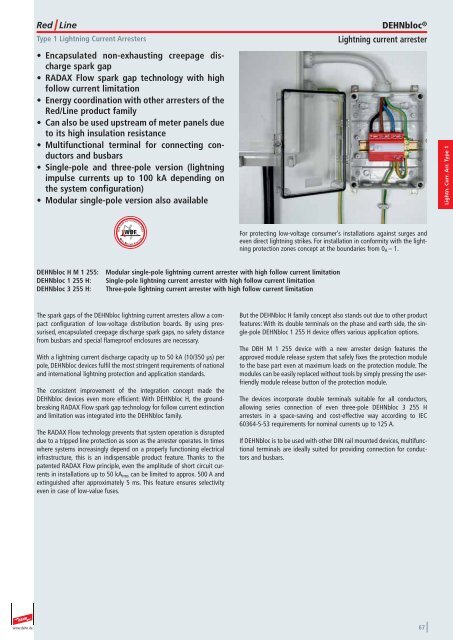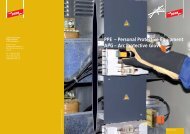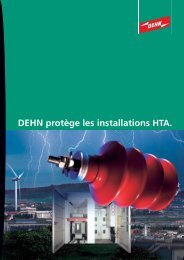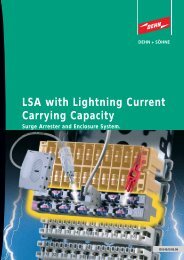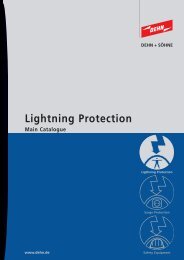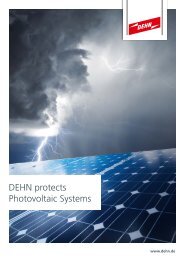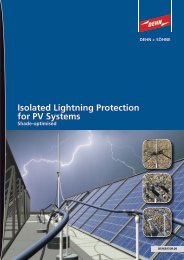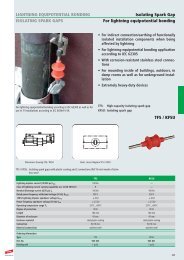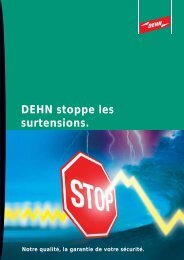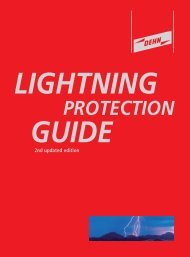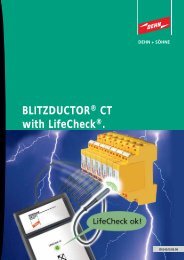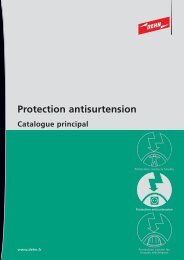- Page 1 and 2:
Surge Protection Main Catalogue 201
- Page 3 and 4:
Contents Page Our promise - DEHN pr
- Page 5 and 6:
DEHN protects Our family-owned comp
- Page 7 and 8:
DEHN - worldwide Algeria Argentina
- Page 9 and 10:
DEHN - Safety according to Specific
- Page 11 and 12:
DEHN - Technical Definitions Lightn
- Page 13 and 14:
Surge protection for POWER SUPPLY S
- Page 15 and 16:
Contents Easy Choice 15 Combined SP
- Page 17 and 18: S-Schutz Easy Choice L1 L2 L3 N PE
- Page 19 and 20: Easy Choice L1 L2 L3 N PE 3 A 1 Arr
- Page 21 and 22: S-Schutz Easy Choice L1 L2 L3 N PE
- Page 23 and 24: Easy Choice L1 L2 L3 PEN SPD Type 2
- Page 25 and 26: ÜBERSPANNUNGSSCHUTZ DEFECT FUNCTIO
- Page 27 and 28: Easy Choice of SPDs for Use on roof
- Page 29 and 30: DEHN-FUNKENSTRECKEN-TECHNOLOGIE INS
- Page 31 and 32: Combined SPDs - Type 1 DEHNventil
- Page 33 and 34: DEHNventil ® modular DEHNventil M
- Page 35 and 36: Protection Module for DEHNventil ®
- Page 37 and 38: Combined SPDs - Type 1 DEHNventil
- Page 39 and 40: Combined SPDs - Type 1 DEHNventil
- Page 41 and 42: L L' N/PE(N) Combined SPDs - Type 1
- Page 43 and 44: DEHNshield ® Combined SPDs - Type
- Page 45 and 46: DEHNshield ® Combined SPDs - Type
- Page 47 and 48: DEHNshield ® Combined SPDs - Type
- Page 49 and 50: DEHNlimit PV 1000 V2 (FM) Combined
- Page 51 and 52: Coordinated Type 1 Lightning Curren
- Page 53 and 54: Coordinated Type 1 Lightning Curren
- Page 55 and 56: Coordinated Type 1 Lightning Curren
- Page 57 and 58: Coordinated Type 1 Lightning Curren
- Page 59 and 60: L L' Coordinated Type 1 Lightning C
- Page 61 and 62: Coordinated Type 1 Lightning Curren
- Page 63 and 64: Accessory for Type 1 Arresters DEHN
- Page 65 and 66: Coordinated Type 1 Lightning Curren
- Page 67: DEHNsecure M DEHNsecure M 2P ... (F
- Page 71 and 72: Type 1 Lightning Current Arresters
- Page 73 and 74: N-PE Lightning Current Arresters
- Page 75 and 76: N-PE Lightning Current Arresters DE
- Page 77 and 78: N-PE Lightning Current Arresters 30
- Page 79 and 80: Type 2 Surge Arresters • Arrester
- Page 81 and 82: S Type 2 Surge Arresters DEHNguard
- Page 83 and 84: Type 2 Surge Arresters DEHNguard ®
- Page 85 and 86: Type 2 Surge Arresters DEHNguard ®
- Page 87 and 88: Type 2 Surge Arresters DEHNguard ®
- Page 89 and 90: Type 2 Surge Arresters DEHNguard ®
- Page 91 and 92: Type 2 Surge Arresters DEHNguard ®
- Page 93 and 94: Type 2 Surge Arresters DEHNguard ®
- Page 95 and 96: Type 2 Surge Arresters DEHNguard ®
- Page 97 and 98: S Type 2 Surge Arresters DEHNguard
- Page 99 and 100: Type 2 Surge Arresters DEHNguard ®
- Page 101 and 102: S Type 2 Surge Arresters DEHNguard
- Page 103 and 104: Type 2 Surge Arresters DEHNguard ®
- Page 105 and 106: Type 2 Surge Arresters • Specific
- Page 107 and 108: Type 2 Surge Arr. for Use in PV Sys
- Page 109 and 110: Type 2 Surge Arresters for Use in P
- Page 111 and 112: Type 2 Surge Arresters for Use in P
- Page 113 and 114: S Type 2 Surge Arresters Protection
- Page 115 and 116: Type 2 Surge Arresters • High dis
- Page 117 and 118: Type 2 Surge Arresters • Surge ar
- Page 119 and 120:
Type 2 Surge Arresters V NH / VA NH
- Page 121 and 122:
Type 3 Surge Arresters • Two-pole
- Page 123 and 124:
Type 3 Surge Arresters DEHNrail mod
- Page 125 and 126:
Type 3 Surge Arresters DEHNrail mod
- Page 127 and 128:
Type 3 Surge Arresters • Protecti
- Page 129 and 130:
Type 3 Surge Arresters SPS Protecto
- Page 131 and 132:
Type 3 Surge Arresters DEHNsafe 31
- Page 133 and 134:
Type 3 Surge Arresters NSM Protecto
- Page 135 and 136:
Type 3 Surge Arresters STC Module 5
- Page 137 and 138:
Type 3 Surge Arresters DEHNflex DEH
- Page 139 and 140:
Type 3 Surge Arresters DEHNflex DEH
- Page 141 and 142:
12 11 L N 12 11 Type 3 Surge Arrest
- Page 143 and 144:
Type 3 Surge Arresters DEHNprotecto
- Page 145 and 146:
Type 3 Surge Arresters • Surge pr
- Page 147 and 148:
Type 3 Surge Arresters L/N SFL Prot
- Page 149 and 150:
General Accessory DEHNpanel • Vis
- Page 151 and 152:
General Accessory • Allows an EMC
- Page 153 and 154:
General Accessory Insulating Enclos
- Page 155 and 156:
General Accessory Busbars / Modular
- Page 157 and 158:
Surge protection for INFORMATION TE
- Page 159 and 160:
1 2 3 4 5 6 7 8 9 0 Contents Easy c
- Page 161 and 162:
Easy Choice according to Interface
- Page 163 and 164:
Easy Choice according to Interface
- Page 165 and 166:
Easy Choice according to Interface
- Page 167 and 168:
Easy Choice according to Interface
- Page 169 and 170:
Easy Choice according to Interface
- Page 171 and 172:
Easy Choice according to Interface
- Page 173 and 174:
Easy Choice according to Interface
- Page 175 and 176:
Easy Choice according to Interface
- Page 177 and 178:
Easy Choice according to Interface
- Page 179 and 180:
SPDs for Information Technology Sys
- Page 181 and 182:
LifeCheck ® SPD Test SPD diagnosti
- Page 183 and 184:
Pluggable DIN Rail Mounted SPDs •
- Page 185 and 186:
Pluggable DIN Rail Mounted SPDs BLI
- Page 187 and 188:
Pluggable DIN Rail Mounted SPDs BLI
- Page 189 and 190:
Pluggable DIN Rail Mounted SPD BLIT
- Page 191 and 192:
Pluggable DIN Rail Mounted SPDs BLI
- Page 193 and 194:
Pluggable DIN Rail Mounted SPDs BLI
- Page 195 and 196:
Pluggable DIN Rail Mounted SPDs BLI
- Page 197 and 198:
Pluggable DIN Rail Mounted SPDs BLI
- Page 199 and 200:
Pluggable DIN Rail Mounted SPDs BLI
- Page 201 and 202:
Pluggable DIN Rail Mounted SPDs BLI
- Page 203 and 204:
Pluggable DIN Rail Mounted SPDs BLI
- Page 205 and 206:
Pluggable DIN Rail Mounted SPDs BLI
- Page 207 and 208:
BLITZDUCTOR ® XT LifeCheck ® Modu
- Page 209 and 210:
Pluggable DIN Rail Mounted SPDs Acc
- Page 211 and 212:
Pluggable DIN Rail Mounted SPDs BLI
- Page 213 and 214:
Compact DIN Rail Mounted SPDs • M
- Page 215 and 216:
Compact DIN Rail Mounted SPDs DEHNc
- Page 217 and 218:
Compact DIN Rail Mounted SPDs DEHNc
- Page 219 and 220:
Compact DIN Rail Mounted SPDs DEHNc
- Page 221 and 222:
Compact DIN Rail Mounted SPDs Acces
- Page 223 and 224:
Compact DIN Rail Mounted SPDs BLITZ
- Page 225 and 226:
Compact DIN Rail Mounted SPDs BLITZ
- Page 227 and 228:
Compact DIN Rail Mounted SPDs BLITZ
- Page 229 and 230:
Compact DIN Rail Mounted SPDs BLITZ
- Page 231 and 232:
D P M P Compact DIN Rail Mounted SP
- Page 233 and 234:
SPDs for LSA Technology • Variabl
- Page 235 and 236:
SPDs for LSA Technology DEHNrapid
- Page 237 and 238:
SPDs for LSA Technology DEHNrapid
- Page 239 and 240:
SPDs for LSA Technology DEHNrapid
- Page 241 and 242:
SPDs for LSA Technology Accessories
- Page 243 and 244:
SPDs for LSA Technology • Suitabl
- Page 245 and 246:
SPDs for LSA Technology • Premoun
- Page 247 and 248:
SPDs for LSA Technology Accessories
- Page 249 and 250:
SPDs for LSA Technology Accessories
- Page 251 and 252:
SPDs for 482.6 mm (19 inch) Data Ca
- Page 253 and 254:
SPDs for 482.6 mm (19 inch) Data Ca
- Page 255 and 256:
SPDs for 482.6 mm (19 inch) Data Ca
- Page 257 and 258:
SPDs for RJ Connection • Patch ca
- Page 259 and 260:
SPDs for RJ Connection DEHNpatch DE
- Page 261 and 262:
SPDs for RJ Connection BLITZDUCTOR
- Page 263 and 264:
SPDs for RJ Connection • Surge ar
- Page 265 and 266:
Surface-Mounted SPDs • Combined l
- Page 267 and 268:
DEHNbox Surface-Mounted SPDs 93 54
- Page 269 and 270:
Surface-Mounted SPDs DEHNlink DLI I
- Page 271 and 272:
Surface-Mounted SPDs DEHNlink DLI T
- Page 273 and 274:
SPDs for Coaxial Connection • Plu
- Page 275 and 276:
SPDs for Coaxial Connection DEHNgat
- Page 277 and 278:
5-3000 MHz SPD No. 909 703 I N 2A U
- Page 279 and 280:
SPDs for Coaxial Connection DEHNgat
- Page 281 and 282:
SPDs for Coaxial Connection DEHNgat
- Page 283 and 284:
SPDs for Coaxial Connection DEHNgat
- Page 285 and 286:
SPDs for Coaxial Connection Accesso
- Page 287 and 288:
SPDs for D-SUB Connection • Surge
- Page 289 and 290:
SPDs for D-SUB Connection FS / USD
- Page 291 and 292:
SPDs for D-SUB Connection FS / USD
- Page 293 and 294:
SPDs for D-SUB Connection FS / USD
- Page 295 and 296:
a1 b1 a2 b2 SPDs for Terminal Conne
- Page 297 and 298:
SPDs for Terminal Connection DSM DS
- Page 299 and 300:
SPDs for Terminal Connection BUStec
- Page 301 and 302:
DEHNpipe DEHNpipe arrester series f
- Page 303 and 304:
929 941 DPI MD 24 M 2S DPI MD 24 M
- Page 305 and 306:
Screwable SPDs Accessories for DEHN
- Page 307 and 308:
SPDs for Use in Potentially Explosi
- Page 309 and 310:
SPDs for Use in Potentially Explosi
- Page 311 and 312:
SPDs for Use in Potentially Explosi
- Page 313 and 314:
SPDs for Use in Potentially Explosi
- Page 315 and 316:
SPDs for Use in Potentially Explosi
- Page 317 and 318:
SPDs for Use in Potentially Explosi
- Page 319 and 320:
SPDs for Use in Potentially Explosi
- Page 321 and 322:
SPDs for Use in Potentially Explosi
- Page 323 and 324:
SPDs for Use in Potentially Explosi
- Page 325 and 326:
SPDs for Use in Potentially Explosi
- Page 327 and 328:
SPDs for Use in Potentially Explosi
- Page 329 and 330:
SPDs for Use in Potentially Explosi
- Page 331 and 332:
SPDs for Use in Potentially Explosi
- Page 333 and 334:
SPDs for Use in Potentially Explosi
- Page 335 and 336:
Accessory for Terminal Block System
- Page 337 and 338:
Accessory for Terminal Block System
- Page 339 and 340:
Accessory for Terminal Block System
- Page 341 and 342:
Accessory for Terminal Block System
- Page 343 and 344:
Accessory for Terminal Block System
- Page 345 and 346:
Combined Adapters • Surge protect
- Page 347 and 348:
909 310 DPRO 230 NT DPRO 230 NT 909
- Page 349 and 350:
909 321 DPRO 230 LAN100 DPRO 230 LA
- Page 351 and 352:
Lightning Equipotential Bonding Iso
- Page 353 and 354:
Lightning Equipotential Bonding Iso
- Page 355 and 356:
Lightning Equipotential Bonding Iso
- Page 357 and 358:
Lightning Equipotential Bonding Iso
- Page 359 and 360:
Lightning Equipotential Bonding Iso
- Page 361 and 362:
Lightning Equipotential Bonding Pip
- Page 363 and 364:
Lightning Equipotential Bonding Iso
- Page 365 and 366:
Lightning Equipotential Bonding Equ
- Page 367 and 368:
Lightning Equipotential Bonding Equ
- Page 369 and 370:
Measuring and Test Devices Conditio
- Page 371 and 372:
Measuring and Test Devices LifeChec
- Page 373 and 374:
Measuring and Test Devices SPD Test
- Page 375 and 376:
Measuring and Test Devices • SPD
- Page 377 and 378:
www.dehn.de 375
- Page 379 and 380:
Information and Documentation Publi
- Page 381 and 382:
Literature IEC 61643-21:2009-04 Low
- Page 383 and 384:
Key to Symbols used in Basic Circui
- Page 385 and 386:
Part No. Index Part No. Type Page P
- Page 387 and 388:
Part No. Index Part No. Type Page P
- Page 389 and 390:
Type / Product Index Type Part No.
- Page 391 and 392:
Type / Product Index Type Part No.
- Page 393 and 394:
Type / Product Index Type Part No.
- Page 395:
Surge Protection Lightning Protecti


